Criminology Report: Examining Big Data Issues in Gov Surveillance
VerifiedAdded on 2023/06/15
|15
|3012
|273
Report
AI Summary
This criminology report delves into the implications of big data for governmental surveillance, highlighting challenges such as finding signals in noise, data silos, data inaccuracy, and the rapid advancement of technology. It addresses key issues for the government, including costs, regulatory hurdles, and the potential for misuse of data, which could amplify inequality. The report also examines privacy implications related to data storage, endpoint security, real-time data security, access control, and human rights. Recommendations include maintaining security in distributed computing frameworks, implementing security practices for non-relational data stores, preserving privacy in data mining and analytics, using encrypted data-centric security, applying granular access control, and ensuring secure storage and transaction logging. Ultimately, the report emphasizes the need for a balanced approach to leverage big data's benefits while mitigating its risks in the context of criminological research and policy.

Running head: CRIMINOLOGY
Criminology
(Big data issue)
Name of the student:
Name of the university:
Author Note
Criminology
(Big data issue)
Name of the student:
Name of the university:
Author Note
Paraphrase This Document
Need a fresh take? Get an instant paraphrase of this document with our AI Paraphraser
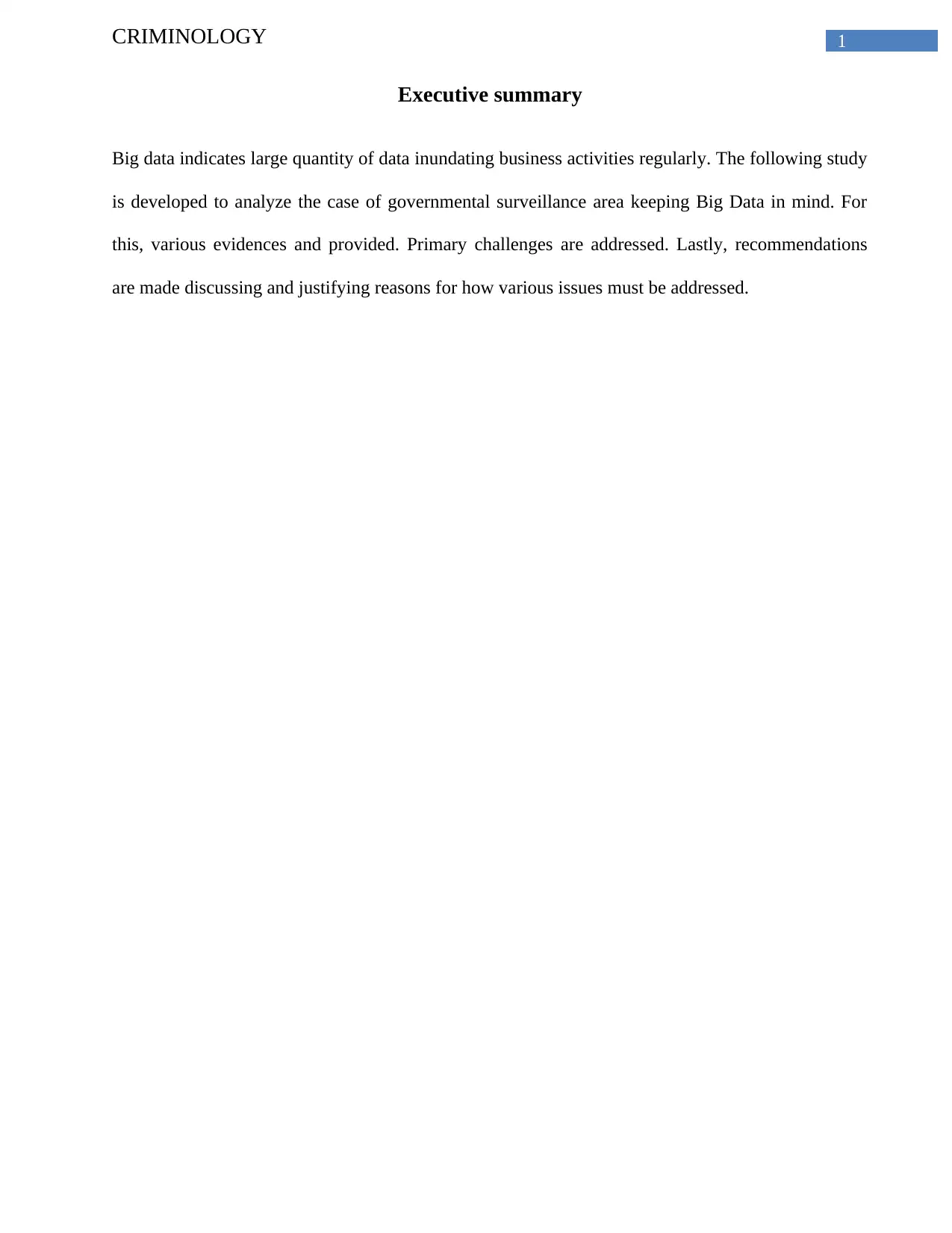
1CRIMINOLOGY
Executive summary
Big data indicates large quantity of data inundating business activities regularly. The following study
is developed to analyze the case of governmental surveillance area keeping Big Data in mind. For
this, various evidences and provided. Primary challenges are addressed. Lastly, recommendations
are made discussing and justifying reasons for how various issues must be addressed.
Executive summary
Big data indicates large quantity of data inundating business activities regularly. The following study
is developed to analyze the case of governmental surveillance area keeping Big Data in mind. For
this, various evidences and provided. Primary challenges are addressed. Lastly, recommendations
are made discussing and justifying reasons for how various issues must be addressed.
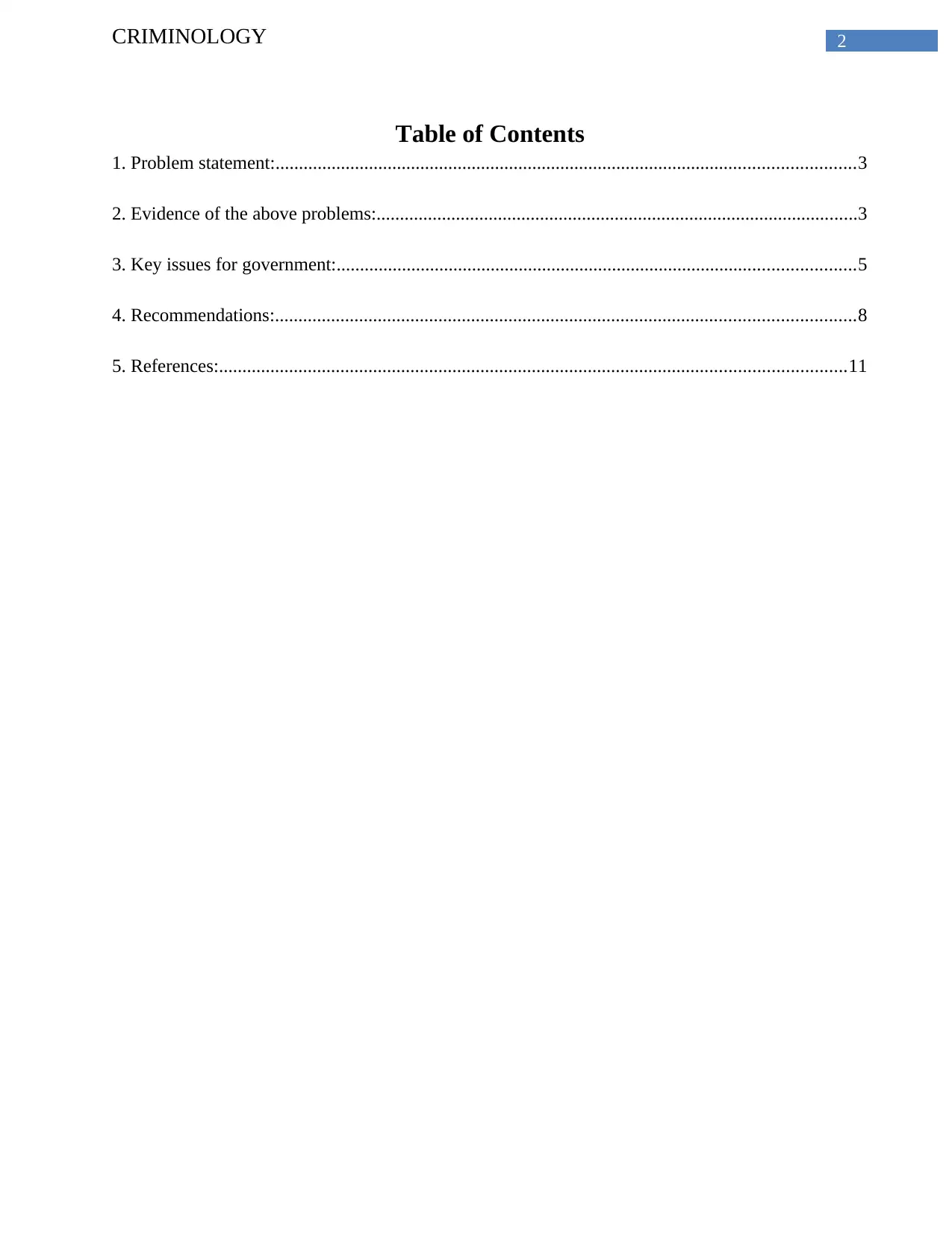
2CRIMINOLOGY
Table of Contents
1. Problem statement:............................................................................................................................3
2. Evidence of the above problems:.......................................................................................................3
3. Key issues for government:...............................................................................................................5
4. Recommendations:............................................................................................................................8
5. References:......................................................................................................................................11
Table of Contents
1. Problem statement:............................................................................................................................3
2. Evidence of the above problems:.......................................................................................................3
3. Key issues for government:...............................................................................................................5
4. Recommendations:............................................................................................................................8
5. References:......................................................................................................................................11
⊘ This is a preview!⊘
Do you want full access?
Subscribe today to unlock all pages.

Trusted by 1+ million students worldwide
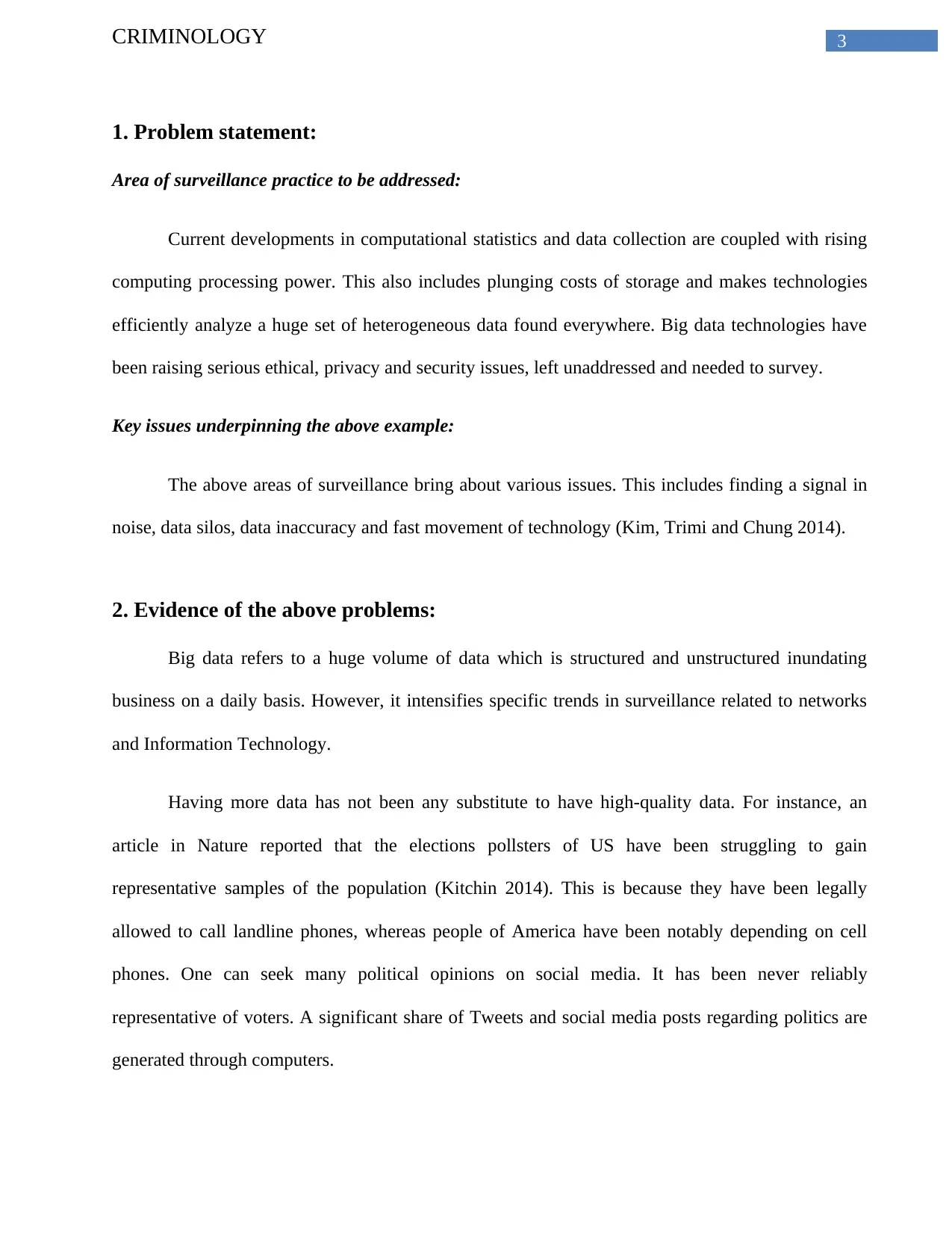
3CRIMINOLOGY
1. Problem statement:
Area of surveillance practice to be addressed:
Current developments in computational statistics and data collection are coupled with rising
computing processing power. This also includes plunging costs of storage and makes technologies
efficiently analyze a huge set of heterogeneous data found everywhere. Big data technologies have
been raising serious ethical, privacy and security issues, left unaddressed and needed to survey.
Key issues underpinning the above example:
The above areas of surveillance bring about various issues. This includes finding a signal in
noise, data silos, data inaccuracy and fast movement of technology (Kim, Trimi and Chung 2014).
2. Evidence of the above problems:
Big data refers to a huge volume of data which is structured and unstructured inundating
business on a daily basis. However, it intensifies specific trends in surveillance related to networks
and Information Technology.
Having more data has not been any substitute to have high-quality data. For instance, an
article in Nature reported that the elections pollsters of US have been struggling to gain
representative samples of the population (Kitchin 2014). This is because they have been legally
allowed to call landline phones, whereas people of America have been notably depending on cell
phones. One can seek many political opinions on social media. It has been never reliably
representative of voters. A significant share of Tweets and social media posts regarding politics are
generated through computers.
1. Problem statement:
Area of surveillance practice to be addressed:
Current developments in computational statistics and data collection are coupled with rising
computing processing power. This also includes plunging costs of storage and makes technologies
efficiently analyze a huge set of heterogeneous data found everywhere. Big data technologies have
been raising serious ethical, privacy and security issues, left unaddressed and needed to survey.
Key issues underpinning the above example:
The above areas of surveillance bring about various issues. This includes finding a signal in
noise, data silos, data inaccuracy and fast movement of technology (Kim, Trimi and Chung 2014).
2. Evidence of the above problems:
Big data refers to a huge volume of data which is structured and unstructured inundating
business on a daily basis. However, it intensifies specific trends in surveillance related to networks
and Information Technology.
Having more data has not been any substitute to have high-quality data. For instance, an
article in Nature reported that the elections pollsters of US have been struggling to gain
representative samples of the population (Kitchin 2014). This is because they have been legally
allowed to call landline phones, whereas people of America have been notably depending on cell
phones. One can seek many political opinions on social media. It has been never reliably
representative of voters. A significant share of Tweets and social media posts regarding politics are
generated through computers.
Paraphrase This Document
Need a fresh take? Get an instant paraphrase of this document with our AI Paraphraser
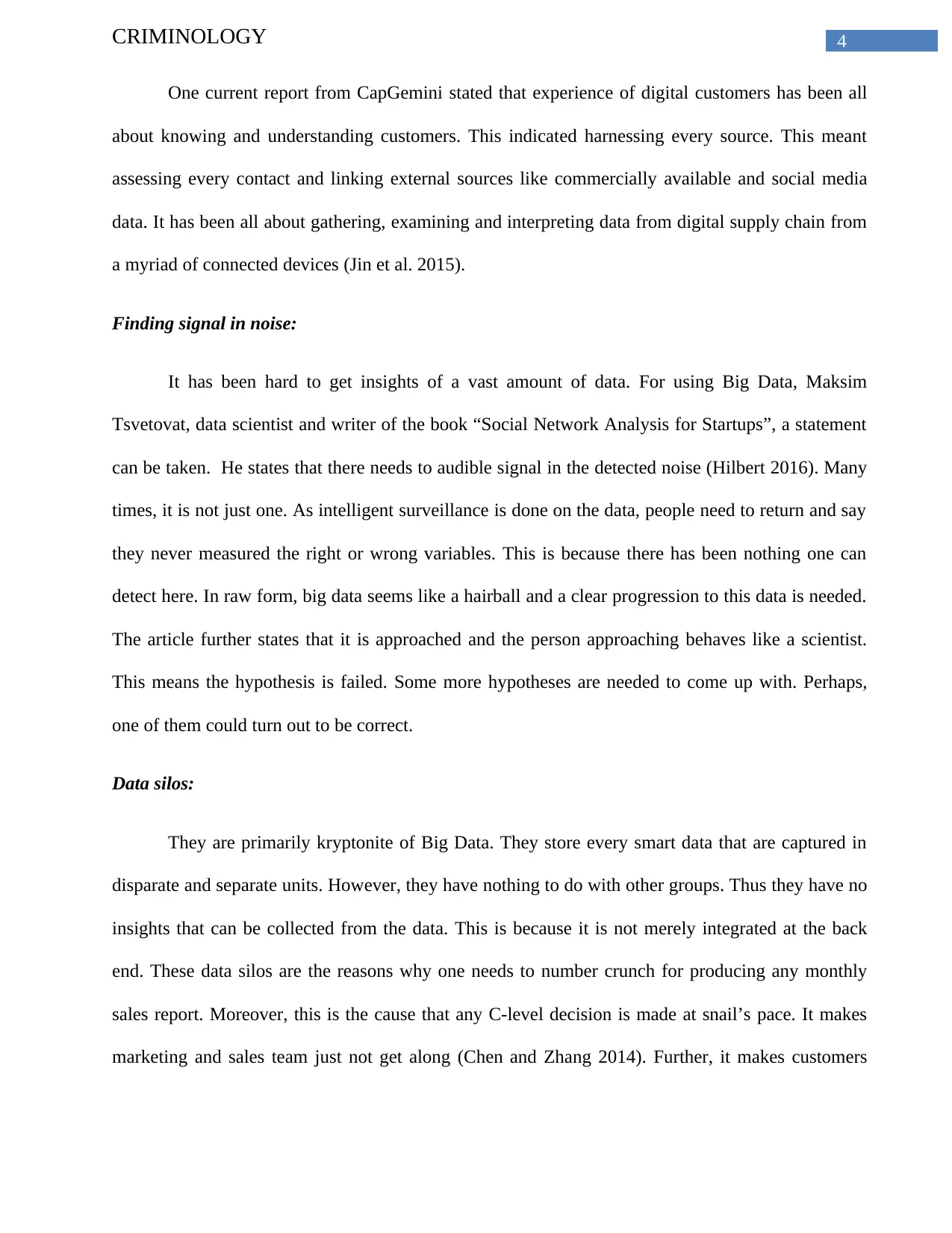
4CRIMINOLOGY
One current report from CapGemini stated that experience of digital customers has been all
about knowing and understanding customers. This indicated harnessing every source. This meant
assessing every contact and linking external sources like commercially available and social media
data. It has been all about gathering, examining and interpreting data from digital supply chain from
a myriad of connected devices (Jin et al. 2015).
Finding signal in noise:
It has been hard to get insights of a vast amount of data. For using Big Data, Maksim
Tsvetovat, data scientist and writer of the book “Social Network Analysis for Startups”, a statement
can be taken. He states that there needs to audible signal in the detected noise (Hilbert 2016). Many
times, it is not just one. As intelligent surveillance is done on the data, people need to return and say
they never measured the right or wrong variables. This is because there has been nothing one can
detect here. In raw form, big data seems like a hairball and a clear progression to this data is needed.
The article further states that it is approached and the person approaching behaves like a scientist.
This means the hypothesis is failed. Some more hypotheses are needed to come up with. Perhaps,
one of them could turn out to be correct.
Data silos:
They are primarily kryptonite of Big Data. They store every smart data that are captured in
disparate and separate units. However, they have nothing to do with other groups. Thus they have no
insights that can be collected from the data. This is because it is not merely integrated at the back
end. These data silos are the reasons why one needs to number crunch for producing any monthly
sales report. Moreover, this is the cause that any C-level decision is made at snail’s pace. It makes
marketing and sales team just not get along (Chen and Zhang 2014). Further, it makes customers
One current report from CapGemini stated that experience of digital customers has been all
about knowing and understanding customers. This indicated harnessing every source. This meant
assessing every contact and linking external sources like commercially available and social media
data. It has been all about gathering, examining and interpreting data from digital supply chain from
a myriad of connected devices (Jin et al. 2015).
Finding signal in noise:
It has been hard to get insights of a vast amount of data. For using Big Data, Maksim
Tsvetovat, data scientist and writer of the book “Social Network Analysis for Startups”, a statement
can be taken. He states that there needs to audible signal in the detected noise (Hilbert 2016). Many
times, it is not just one. As intelligent surveillance is done on the data, people need to return and say
they never measured the right or wrong variables. This is because there has been nothing one can
detect here. In raw form, big data seems like a hairball and a clear progression to this data is needed.
The article further states that it is approached and the person approaching behaves like a scientist.
This means the hypothesis is failed. Some more hypotheses are needed to come up with. Perhaps,
one of them could turn out to be correct.
Data silos:
They are primarily kryptonite of Big Data. They store every smart data that are captured in
disparate and separate units. However, they have nothing to do with other groups. Thus they have no
insights that can be collected from the data. This is because it is not merely integrated at the back
end. These data silos are the reasons why one needs to number crunch for producing any monthly
sales report. Moreover, this is the cause that any C-level decision is made at snail’s pace. It makes
marketing and sales team just not get along (Chen and Zhang 2014). Further, it makes customers
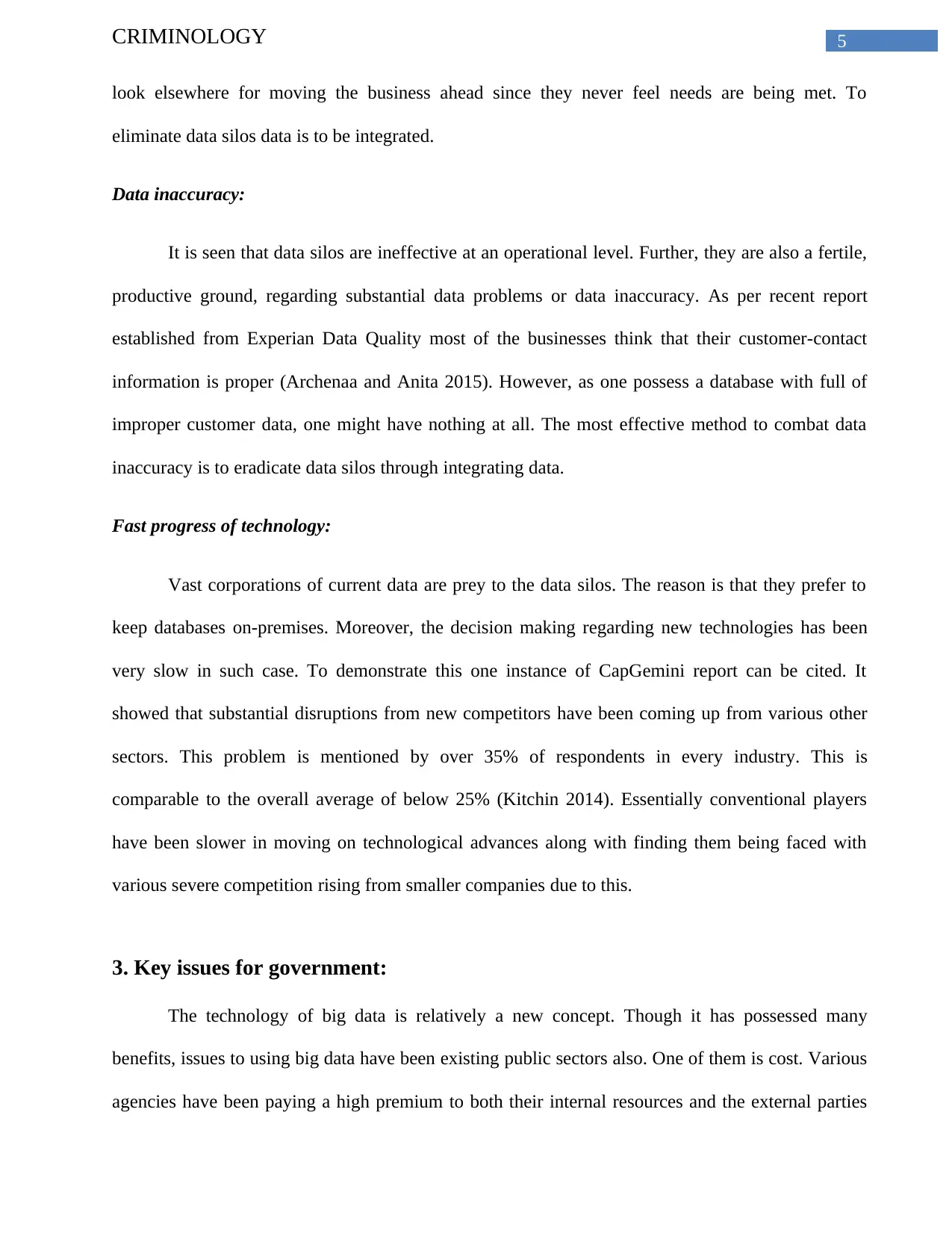
5CRIMINOLOGY
look elsewhere for moving the business ahead since they never feel needs are being met. To
eliminate data silos data is to be integrated.
Data inaccuracy:
It is seen that data silos are ineffective at an operational level. Further, they are also a fertile,
productive ground, regarding substantial data problems or data inaccuracy. As per recent report
established from Experian Data Quality most of the businesses think that their customer-contact
information is proper (Archenaa and Anita 2015). However, as one possess a database with full of
improper customer data, one might have nothing at all. The most effective method to combat data
inaccuracy is to eradicate data silos through integrating data.
Fast progress of technology:
Vast corporations of current data are prey to the data silos. The reason is that they prefer to
keep databases on-premises. Moreover, the decision making regarding new technologies has been
very slow in such case. To demonstrate this one instance of CapGemini report can be cited. It
showed that substantial disruptions from new competitors have been coming up from various other
sectors. This problem is mentioned by over 35% of respondents in every industry. This is
comparable to the overall average of below 25% (Kitchin 2014). Essentially conventional players
have been slower in moving on technological advances along with finding them being faced with
various severe competition rising from smaller companies due to this.
3. Key issues for government:
The technology of big data is relatively a new concept. Though it has possessed many
benefits, issues to using big data have been existing public sectors also. One of them is cost. Various
agencies have been paying a high premium to both their internal resources and the external parties
look elsewhere for moving the business ahead since they never feel needs are being met. To
eliminate data silos data is to be integrated.
Data inaccuracy:
It is seen that data silos are ineffective at an operational level. Further, they are also a fertile,
productive ground, regarding substantial data problems or data inaccuracy. As per recent report
established from Experian Data Quality most of the businesses think that their customer-contact
information is proper (Archenaa and Anita 2015). However, as one possess a database with full of
improper customer data, one might have nothing at all. The most effective method to combat data
inaccuracy is to eradicate data silos through integrating data.
Fast progress of technology:
Vast corporations of current data are prey to the data silos. The reason is that they prefer to
keep databases on-premises. Moreover, the decision making regarding new technologies has been
very slow in such case. To demonstrate this one instance of CapGemini report can be cited. It
showed that substantial disruptions from new competitors have been coming up from various other
sectors. This problem is mentioned by over 35% of respondents in every industry. This is
comparable to the overall average of below 25% (Kitchin 2014). Essentially conventional players
have been slower in moving on technological advances along with finding them being faced with
various severe competition rising from smaller companies due to this.
3. Key issues for government:
The technology of big data is relatively a new concept. Though it has possessed many
benefits, issues to using big data have been existing public sectors also. One of them is cost. Various
agencies have been paying a high premium to both their internal resources and the external parties
⊘ This is a preview!⊘
Do you want full access?
Subscribe today to unlock all pages.

Trusted by 1+ million students worldwide
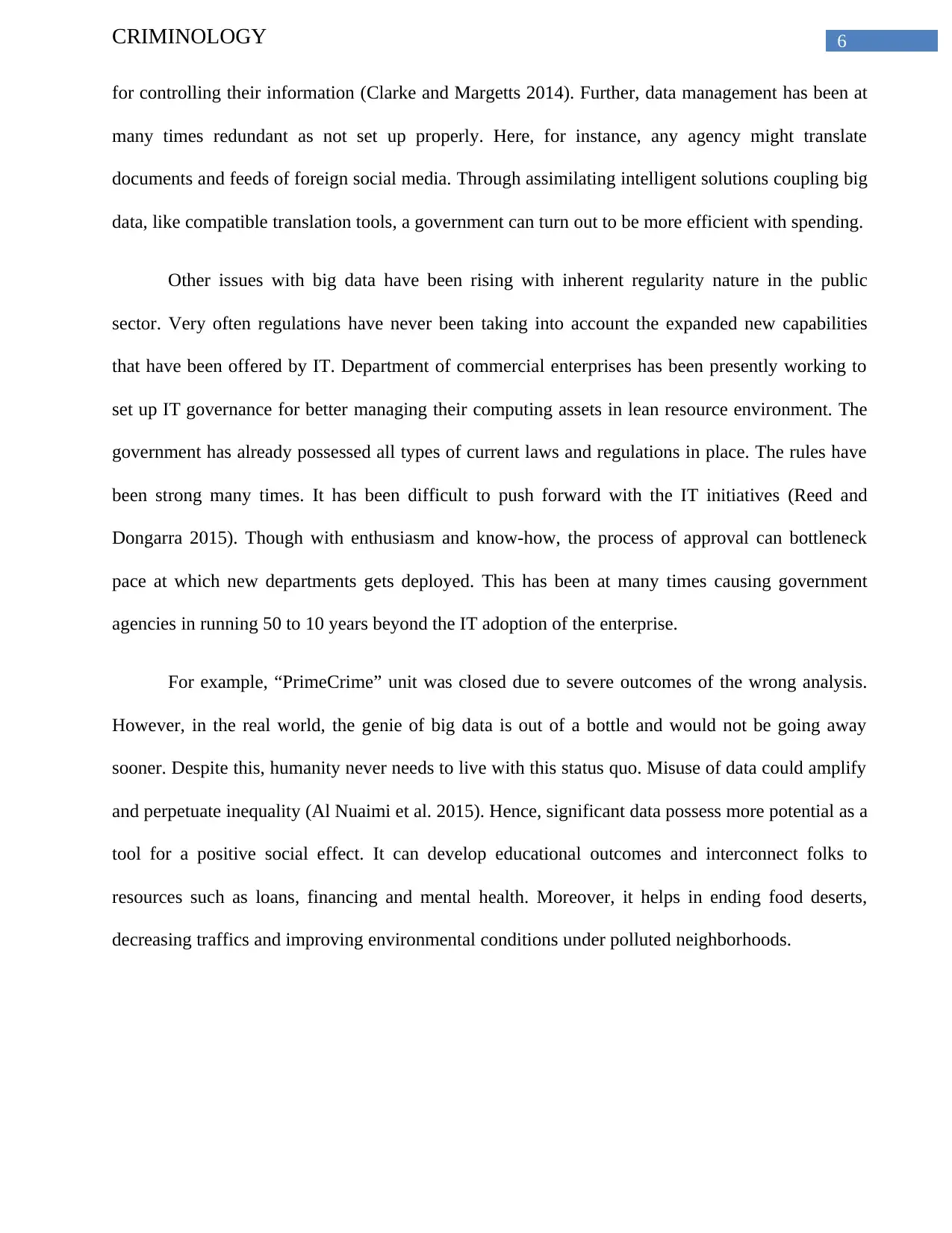
6CRIMINOLOGY
for controlling their information (Clarke and Margetts 2014). Further, data management has been at
many times redundant as not set up properly. Here, for instance, any agency might translate
documents and feeds of foreign social media. Through assimilating intelligent solutions coupling big
data, like compatible translation tools, a government can turn out to be more efficient with spending.
Other issues with big data have been rising with inherent regularity nature in the public
sector. Very often regulations have never been taking into account the expanded new capabilities
that have been offered by IT. Department of commercial enterprises has been presently working to
set up IT governance for better managing their computing assets in lean resource environment. The
government has already possessed all types of current laws and regulations in place. The rules have
been strong many times. It has been difficult to push forward with the IT initiatives (Reed and
Dongarra 2015). Though with enthusiasm and know-how, the process of approval can bottleneck
pace at which new departments gets deployed. This has been at many times causing government
agencies in running 50 to 10 years beyond the IT adoption of the enterprise.
For example, “PrimeCrime” unit was closed due to severe outcomes of the wrong analysis.
However, in the real world, the genie of big data is out of a bottle and would not be going away
sooner. Despite this, humanity never needs to live with this status quo. Misuse of data could amplify
and perpetuate inequality (Al Nuaimi et al. 2015). Hence, significant data possess more potential as a
tool for a positive social effect. It can develop educational outcomes and interconnect folks to
resources such as loans, financing and mental health. Moreover, it helps in ending food deserts,
decreasing traffics and improving environmental conditions under polluted neighborhoods.
for controlling their information (Clarke and Margetts 2014). Further, data management has been at
many times redundant as not set up properly. Here, for instance, any agency might translate
documents and feeds of foreign social media. Through assimilating intelligent solutions coupling big
data, like compatible translation tools, a government can turn out to be more efficient with spending.
Other issues with big data have been rising with inherent regularity nature in the public
sector. Very often regulations have never been taking into account the expanded new capabilities
that have been offered by IT. Department of commercial enterprises has been presently working to
set up IT governance for better managing their computing assets in lean resource environment. The
government has already possessed all types of current laws and regulations in place. The rules have
been strong many times. It has been difficult to push forward with the IT initiatives (Reed and
Dongarra 2015). Though with enthusiasm and know-how, the process of approval can bottleneck
pace at which new departments gets deployed. This has been at many times causing government
agencies in running 50 to 10 years beyond the IT adoption of the enterprise.
For example, “PrimeCrime” unit was closed due to severe outcomes of the wrong analysis.
However, in the real world, the genie of big data is out of a bottle and would not be going away
sooner. Despite this, humanity never needs to live with this status quo. Misuse of data could amplify
and perpetuate inequality (Al Nuaimi et al. 2015). Hence, significant data possess more potential as a
tool for a positive social effect. It can develop educational outcomes and interconnect folks to
resources such as loans, financing and mental health. Moreover, it helps in ending food deserts,
decreasing traffics and improving environmental conditions under polluted neighborhoods.
Paraphrase This Document
Need a fresh take? Get an instant paraphrase of this document with our AI Paraphraser
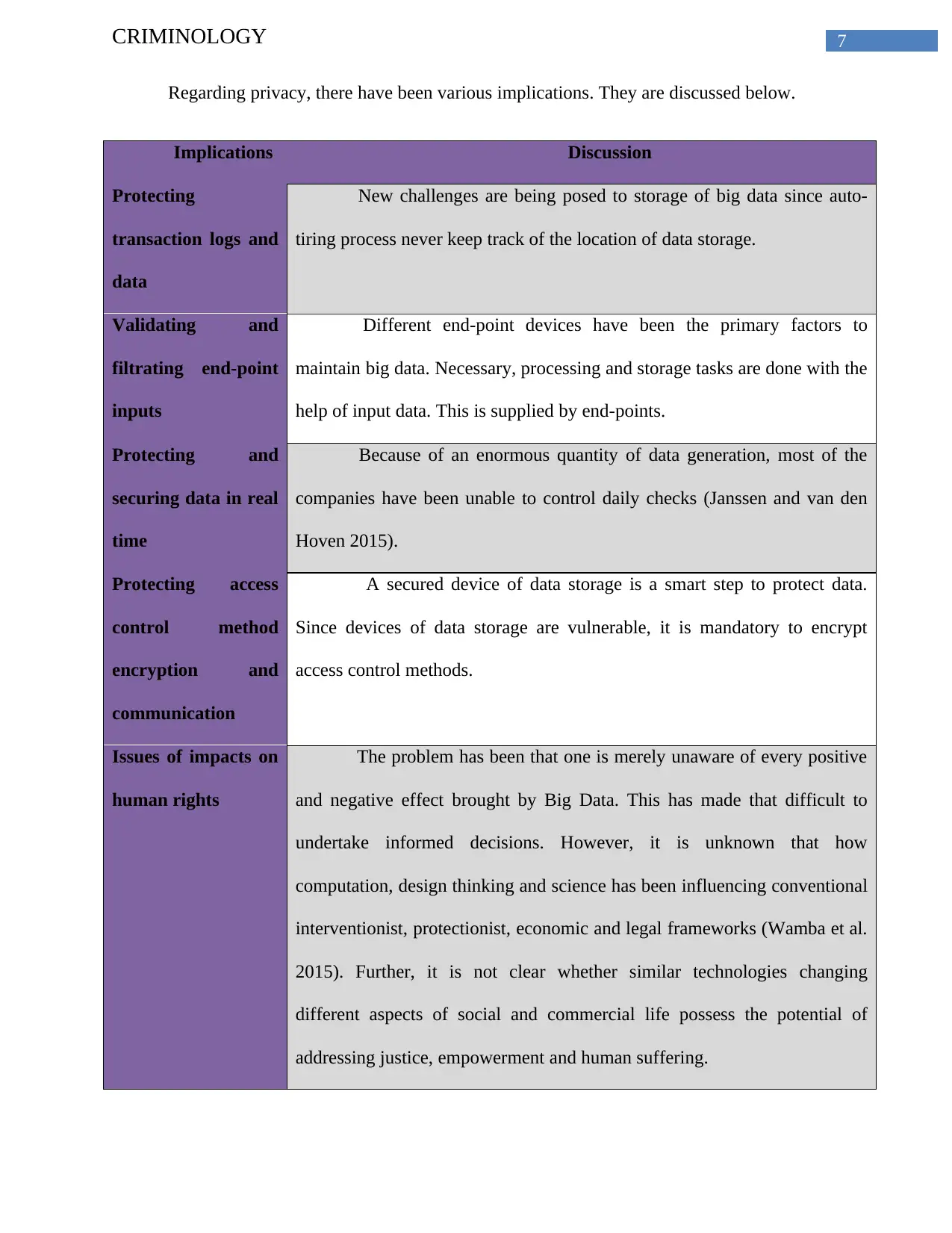
7CRIMINOLOGY
Regarding privacy, there have been various implications. They are discussed below.
Implications Discussion
Protecting
transaction logs and
data
New challenges are being posed to storage of big data since auto-
tiring process never keep track of the location of data storage.
Validating and
filtrating end-point
inputs
Different end-point devices have been the primary factors to
maintain big data. Necessary, processing and storage tasks are done with the
help of input data. This is supplied by end-points.
Protecting and
securing data in real
time
Because of an enormous quantity of data generation, most of the
companies have been unable to control daily checks (Janssen and van den
Hoven 2015).
Protecting access
control method
encryption and
communication
A secured device of data storage is a smart step to protect data.
Since devices of data storage are vulnerable, it is mandatory to encrypt
access control methods.
Issues of impacts on
human rights
The problem has been that one is merely unaware of every positive
and negative effect brought by Big Data. This has made that difficult to
undertake informed decisions. However, it is unknown that how
computation, design thinking and science has been influencing conventional
interventionist, protectionist, economic and legal frameworks (Wamba et al.
2015). Further, it is not clear whether similar technologies changing
different aspects of social and commercial life possess the potential of
addressing justice, empowerment and human suffering.
Regarding privacy, there have been various implications. They are discussed below.
Implications Discussion
Protecting
transaction logs and
data
New challenges are being posed to storage of big data since auto-
tiring process never keep track of the location of data storage.
Validating and
filtrating end-point
inputs
Different end-point devices have been the primary factors to
maintain big data. Necessary, processing and storage tasks are done with the
help of input data. This is supplied by end-points.
Protecting and
securing data in real
time
Because of an enormous quantity of data generation, most of the
companies have been unable to control daily checks (Janssen and van den
Hoven 2015).
Protecting access
control method
encryption and
communication
A secured device of data storage is a smart step to protect data.
Since devices of data storage are vulnerable, it is mandatory to encrypt
access control methods.
Issues of impacts on
human rights
The problem has been that one is merely unaware of every positive
and negative effect brought by Big Data. This has made that difficult to
undertake informed decisions. However, it is unknown that how
computation, design thinking and science has been influencing conventional
interventionist, protectionist, economic and legal frameworks (Wamba et al.
2015). Further, it is not clear whether similar technologies changing
different aspects of social and commercial life possess the potential of
addressing justice, empowerment and human suffering.
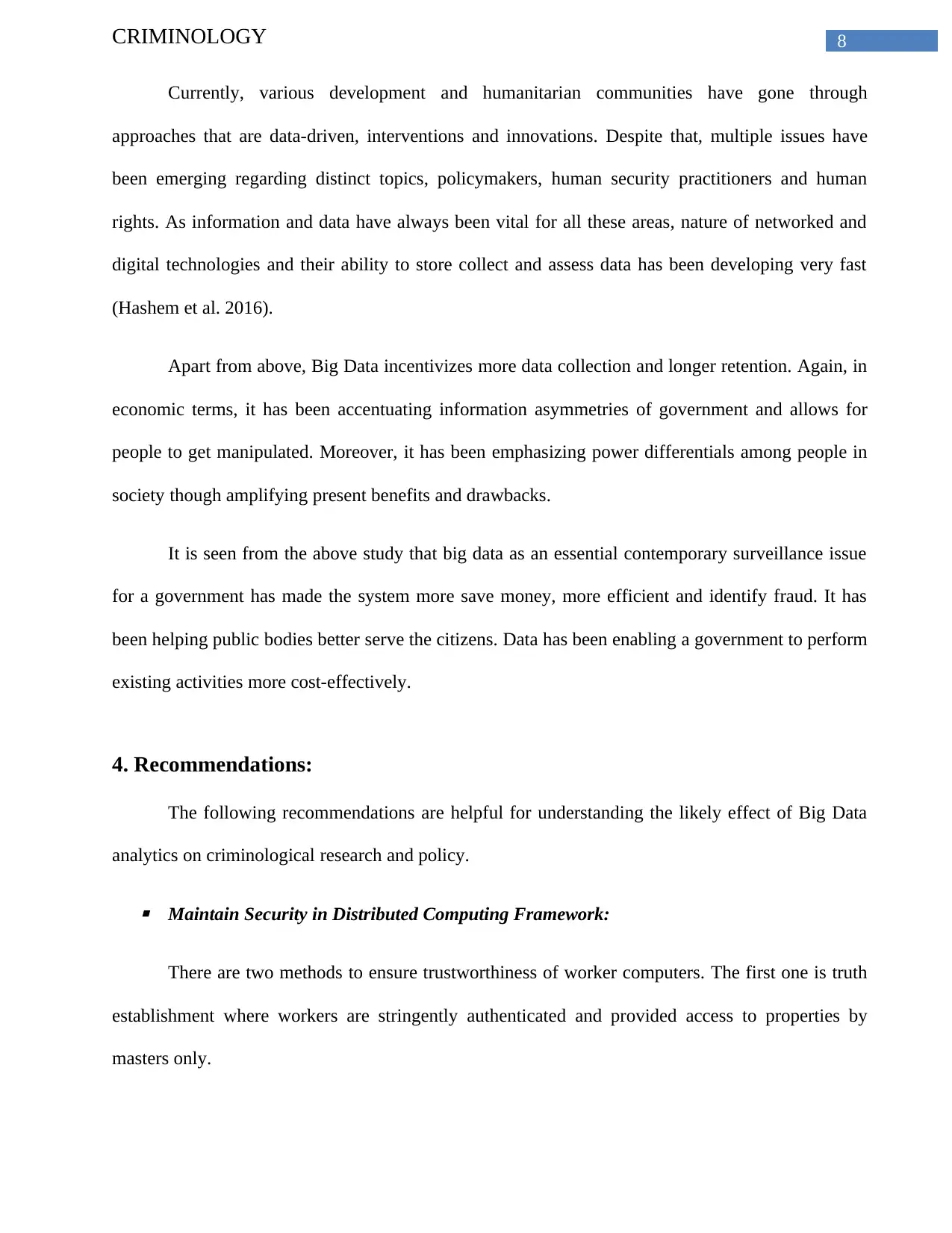
8CRIMINOLOGY
Currently, various development and humanitarian communities have gone through
approaches that are data-driven, interventions and innovations. Despite that, multiple issues have
been emerging regarding distinct topics, policymakers, human security practitioners and human
rights. As information and data have always been vital for all these areas, nature of networked and
digital technologies and their ability to store collect and assess data has been developing very fast
(Hashem et al. 2016).
Apart from above, Big Data incentivizes more data collection and longer retention. Again, in
economic terms, it has been accentuating information asymmetries of government and allows for
people to get manipulated. Moreover, it has been emphasizing power differentials among people in
society though amplifying present benefits and drawbacks.
It is seen from the above study that big data as an essential contemporary surveillance issue
for a government has made the system more save money, more efficient and identify fraud. It has
been helping public bodies better serve the citizens. Data has been enabling a government to perform
existing activities more cost-effectively.
4. Recommendations:
The following recommendations are helpful for understanding the likely effect of Big Data
analytics on criminological research and policy.
Maintain Security in Distributed Computing Framework:
There are two methods to ensure trustworthiness of worker computers. The first one is truth
establishment where workers are stringently authenticated and provided access to properties by
masters only.
Currently, various development and humanitarian communities have gone through
approaches that are data-driven, interventions and innovations. Despite that, multiple issues have
been emerging regarding distinct topics, policymakers, human security practitioners and human
rights. As information and data have always been vital for all these areas, nature of networked and
digital technologies and their ability to store collect and assess data has been developing very fast
(Hashem et al. 2016).
Apart from above, Big Data incentivizes more data collection and longer retention. Again, in
economic terms, it has been accentuating information asymmetries of government and allows for
people to get manipulated. Moreover, it has been emphasizing power differentials among people in
society though amplifying present benefits and drawbacks.
It is seen from the above study that big data as an essential contemporary surveillance issue
for a government has made the system more save money, more efficient and identify fraud. It has
been helping public bodies better serve the citizens. Data has been enabling a government to perform
existing activities more cost-effectively.
4. Recommendations:
The following recommendations are helpful for understanding the likely effect of Big Data
analytics on criminological research and policy.
Maintain Security in Distributed Computing Framework:
There are two methods to ensure trustworthiness of worker computers. The first one is truth
establishment where workers are stringently authenticated and provided access to properties by
masters only.
⊘ This is a preview!⊘
Do you want full access?
Subscribe today to unlock all pages.

Trusted by 1+ million students worldwide
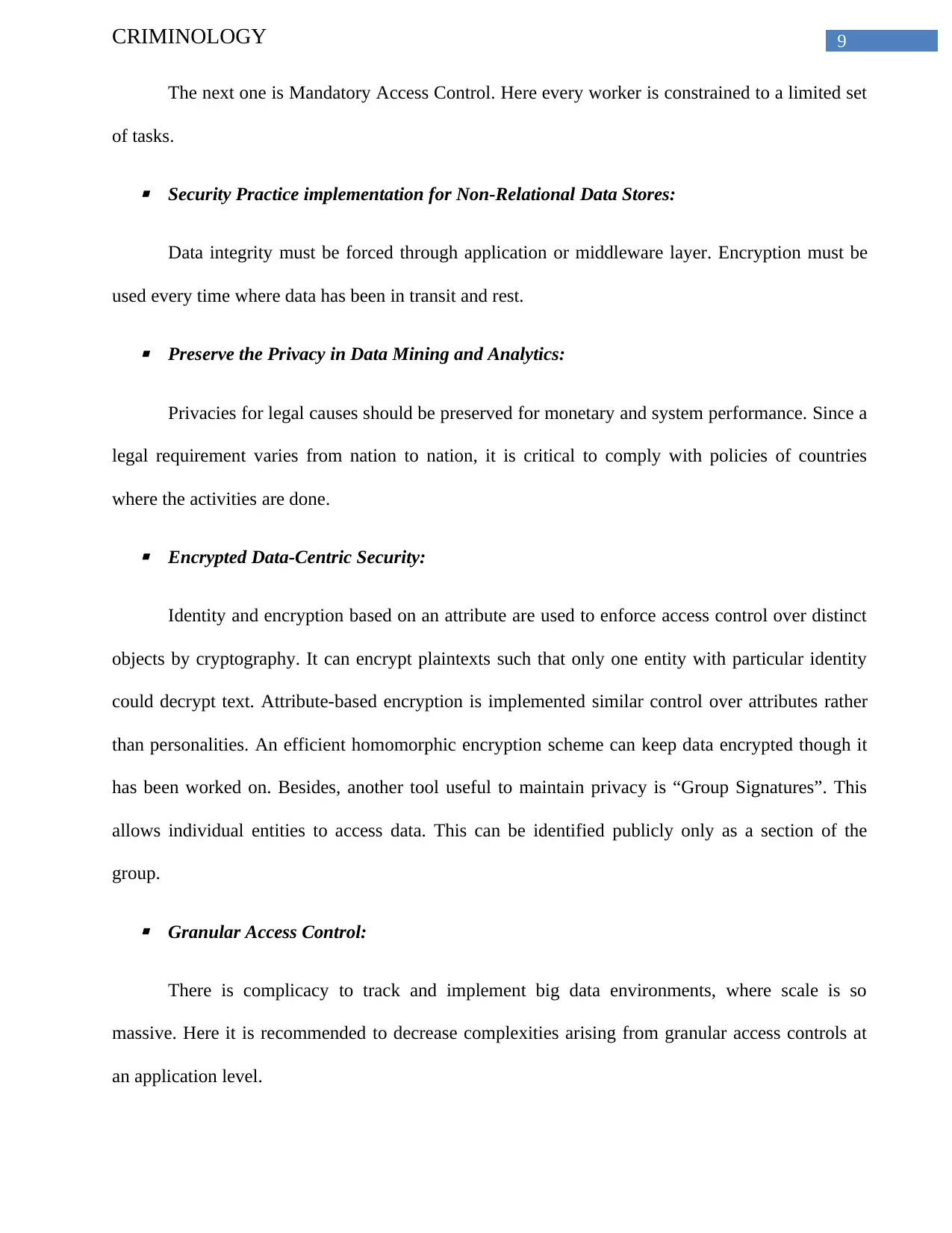
9CRIMINOLOGY
The next one is Mandatory Access Control. Here every worker is constrained to a limited set
of tasks.
Security Practice implementation for Non-Relational Data Stores:
Data integrity must be forced through application or middleware layer. Encryption must be
used every time where data has been in transit and rest.
Preserve the Privacy in Data Mining and Analytics:
Privacies for legal causes should be preserved for monetary and system performance. Since a
legal requirement varies from nation to nation, it is critical to comply with policies of countries
where the activities are done.
Encrypted Data-Centric Security:
Identity and encryption based on an attribute are used to enforce access control over distinct
objects by cryptography. It can encrypt plaintexts such that only one entity with particular identity
could decrypt text. Attribute-based encryption is implemented similar control over attributes rather
than personalities. An efficient homomorphic encryption scheme can keep data encrypted though it
has been worked on. Besides, another tool useful to maintain privacy is “Group Signatures”. This
allows individual entities to access data. This can be identified publicly only as a section of the
group.
Granular Access Control:
There is complicacy to track and implement big data environments, where scale is so
massive. Here it is recommended to decrease complexities arising from granular access controls at
an application level.
The next one is Mandatory Access Control. Here every worker is constrained to a limited set
of tasks.
Security Practice implementation for Non-Relational Data Stores:
Data integrity must be forced through application or middleware layer. Encryption must be
used every time where data has been in transit and rest.
Preserve the Privacy in Data Mining and Analytics:
Privacies for legal causes should be preserved for monetary and system performance. Since a
legal requirement varies from nation to nation, it is critical to comply with policies of countries
where the activities are done.
Encrypted Data-Centric Security:
Identity and encryption based on an attribute are used to enforce access control over distinct
objects by cryptography. It can encrypt plaintexts such that only one entity with particular identity
could decrypt text. Attribute-based encryption is implemented similar control over attributes rather
than personalities. An efficient homomorphic encryption scheme can keep data encrypted though it
has been worked on. Besides, another tool useful to maintain privacy is “Group Signatures”. This
allows individual entities to access data. This can be identified publicly only as a section of the
group.
Granular Access Control:
There is complicacy to track and implement big data environments, where scale is so
massive. Here it is recommended to decrease complexities arising from granular access controls at
an application level.
Paraphrase This Document
Need a fresh take? Get an instant paraphrase of this document with our AI Paraphraser
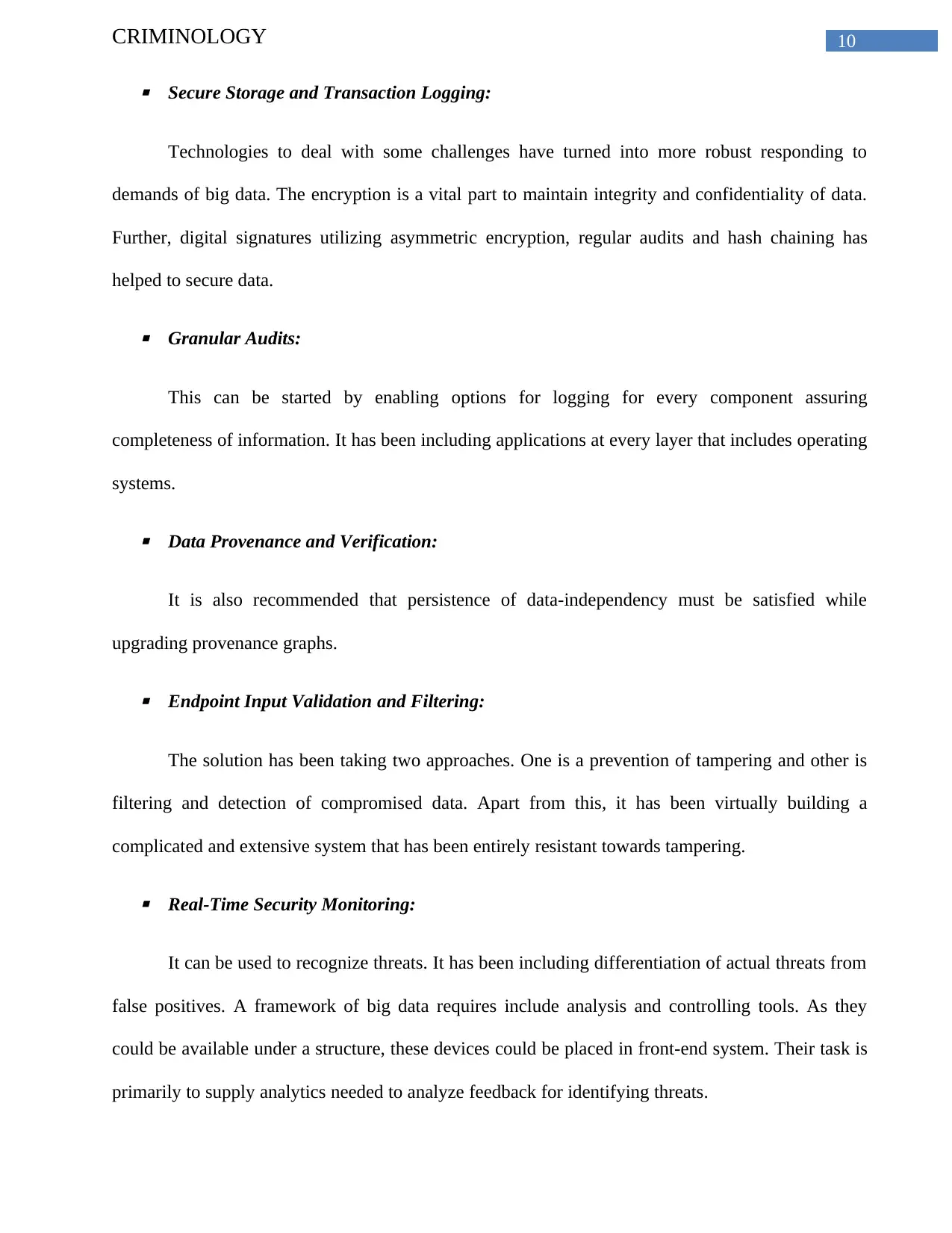
10CRIMINOLOGY
Secure Storage and Transaction Logging:
Technologies to deal with some challenges have turned into more robust responding to
demands of big data. The encryption is a vital part to maintain integrity and confidentiality of data.
Further, digital signatures utilizing asymmetric encryption, regular audits and hash chaining has
helped to secure data.
Granular Audits:
This can be started by enabling options for logging for every component assuring
completeness of information. It has been including applications at every layer that includes operating
systems.
Data Provenance and Verification:
It is also recommended that persistence of data-independency must be satisfied while
upgrading provenance graphs.
Endpoint Input Validation and Filtering:
The solution has been taking two approaches. One is a prevention of tampering and other is
filtering and detection of compromised data. Apart from this, it has been virtually building a
complicated and extensive system that has been entirely resistant towards tampering.
Real-Time Security Monitoring:
It can be used to recognize threats. It has been including differentiation of actual threats from
false positives. A framework of big data requires include analysis and controlling tools. As they
could be available under a structure, these devices could be placed in front-end system. Their task is
primarily to supply analytics needed to analyze feedback for identifying threats.
Secure Storage and Transaction Logging:
Technologies to deal with some challenges have turned into more robust responding to
demands of big data. The encryption is a vital part to maintain integrity and confidentiality of data.
Further, digital signatures utilizing asymmetric encryption, regular audits and hash chaining has
helped to secure data.
Granular Audits:
This can be started by enabling options for logging for every component assuring
completeness of information. It has been including applications at every layer that includes operating
systems.
Data Provenance and Verification:
It is also recommended that persistence of data-independency must be satisfied while
upgrading provenance graphs.
Endpoint Input Validation and Filtering:
The solution has been taking two approaches. One is a prevention of tampering and other is
filtering and detection of compromised data. Apart from this, it has been virtually building a
complicated and extensive system that has been entirely resistant towards tampering.
Real-Time Security Monitoring:
It can be used to recognize threats. It has been including differentiation of actual threats from
false positives. A framework of big data requires include analysis and controlling tools. As they
could be available under a structure, these devices could be placed in front-end system. Their task is
primarily to supply analytics needed to analyze feedback for identifying threats.
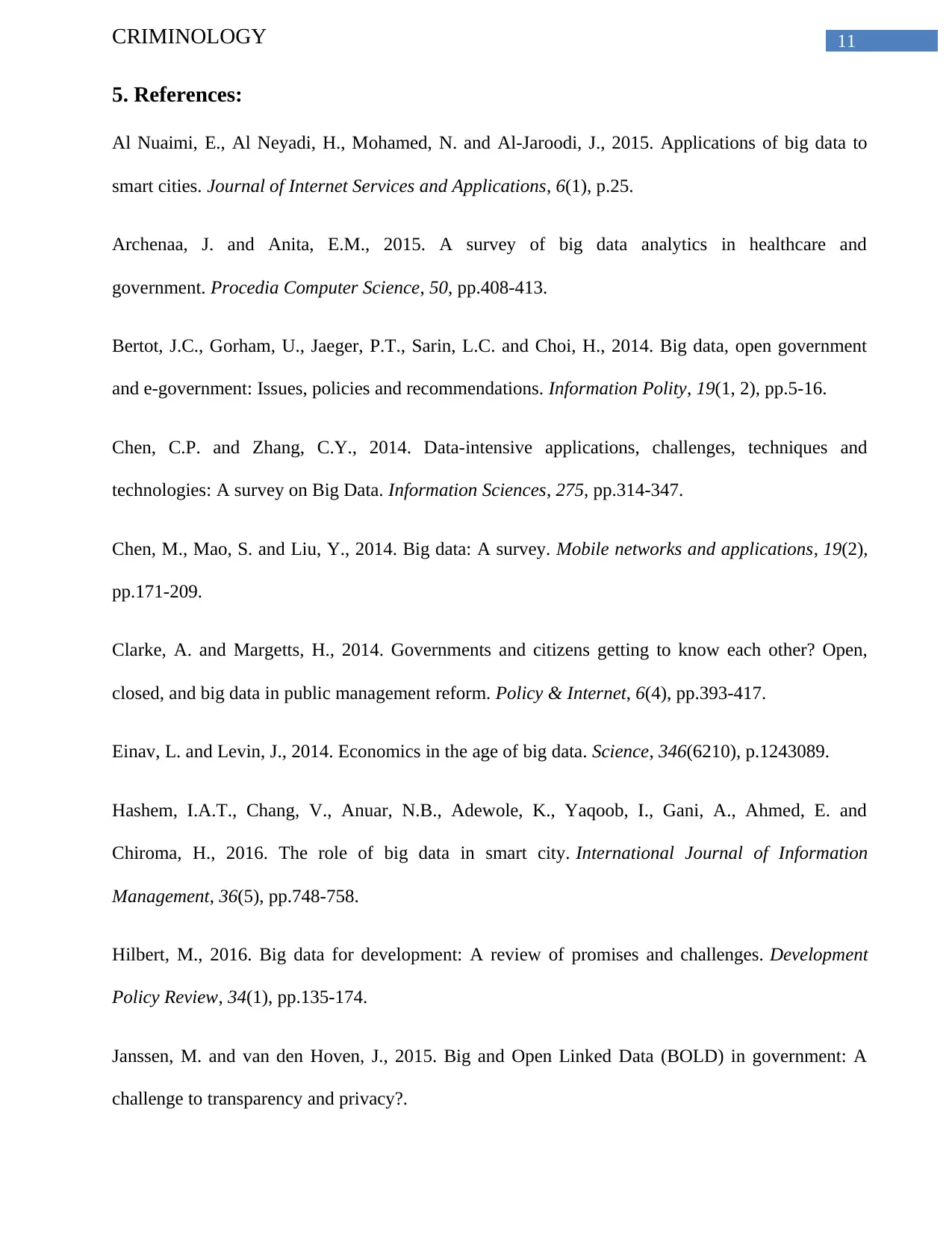
11CRIMINOLOGY
5. References:
Al Nuaimi, E., Al Neyadi, H., Mohamed, N. and Al-Jaroodi, J., 2015. Applications of big data to
smart cities. Journal of Internet Services and Applications, 6(1), p.25.
Archenaa, J. and Anita, E.M., 2015. A survey of big data analytics in healthcare and
government. Procedia Computer Science, 50, pp.408-413.
Bertot, J.C., Gorham, U., Jaeger, P.T., Sarin, L.C. and Choi, H., 2014. Big data, open government
and e-government: Issues, policies and recommendations. Information Polity, 19(1, 2), pp.5-16.
Chen, C.P. and Zhang, C.Y., 2014. Data-intensive applications, challenges, techniques and
technologies: A survey on Big Data. Information Sciences, 275, pp.314-347.
Chen, M., Mao, S. and Liu, Y., 2014. Big data: A survey. Mobile networks and applications, 19(2),
pp.171-209.
Clarke, A. and Margetts, H., 2014. Governments and citizens getting to know each other? Open,
closed, and big data in public management reform. Policy & Internet, 6(4), pp.393-417.
Einav, L. and Levin, J., 2014. Economics in the age of big data. Science, 346(6210), p.1243089.
Hashem, I.A.T., Chang, V., Anuar, N.B., Adewole, K., Yaqoob, I., Gani, A., Ahmed, E. and
Chiroma, H., 2016. The role of big data in smart city. International Journal of Information
Management, 36(5), pp.748-758.
Hilbert, M., 2016. Big data for development: A review of promises and challenges. Development
Policy Review, 34(1), pp.135-174.
Janssen, M. and van den Hoven, J., 2015. Big and Open Linked Data (BOLD) in government: A
challenge to transparency and privacy?.
5. References:
Al Nuaimi, E., Al Neyadi, H., Mohamed, N. and Al-Jaroodi, J., 2015. Applications of big data to
smart cities. Journal of Internet Services and Applications, 6(1), p.25.
Archenaa, J. and Anita, E.M., 2015. A survey of big data analytics in healthcare and
government. Procedia Computer Science, 50, pp.408-413.
Bertot, J.C., Gorham, U., Jaeger, P.T., Sarin, L.C. and Choi, H., 2014. Big data, open government
and e-government: Issues, policies and recommendations. Information Polity, 19(1, 2), pp.5-16.
Chen, C.P. and Zhang, C.Y., 2014. Data-intensive applications, challenges, techniques and
technologies: A survey on Big Data. Information Sciences, 275, pp.314-347.
Chen, M., Mao, S. and Liu, Y., 2014. Big data: A survey. Mobile networks and applications, 19(2),
pp.171-209.
Clarke, A. and Margetts, H., 2014. Governments and citizens getting to know each other? Open,
closed, and big data in public management reform. Policy & Internet, 6(4), pp.393-417.
Einav, L. and Levin, J., 2014. Economics in the age of big data. Science, 346(6210), p.1243089.
Hashem, I.A.T., Chang, V., Anuar, N.B., Adewole, K., Yaqoob, I., Gani, A., Ahmed, E. and
Chiroma, H., 2016. The role of big data in smart city. International Journal of Information
Management, 36(5), pp.748-758.
Hilbert, M., 2016. Big data for development: A review of promises and challenges. Development
Policy Review, 34(1), pp.135-174.
Janssen, M. and van den Hoven, J., 2015. Big and Open Linked Data (BOLD) in government: A
challenge to transparency and privacy?.
⊘ This is a preview!⊘
Do you want full access?
Subscribe today to unlock all pages.

Trusted by 1+ million students worldwide
1 out of 15
Related Documents
Your All-in-One AI-Powered Toolkit for Academic Success.
+13062052269
info@desklib.com
Available 24*7 on WhatsApp / Email
![[object Object]](/_next/static/media/star-bottom.7253800d.svg)
Unlock your academic potential
Copyright © 2020–2025 A2Z Services. All Rights Reserved. Developed and managed by ZUCOL.




